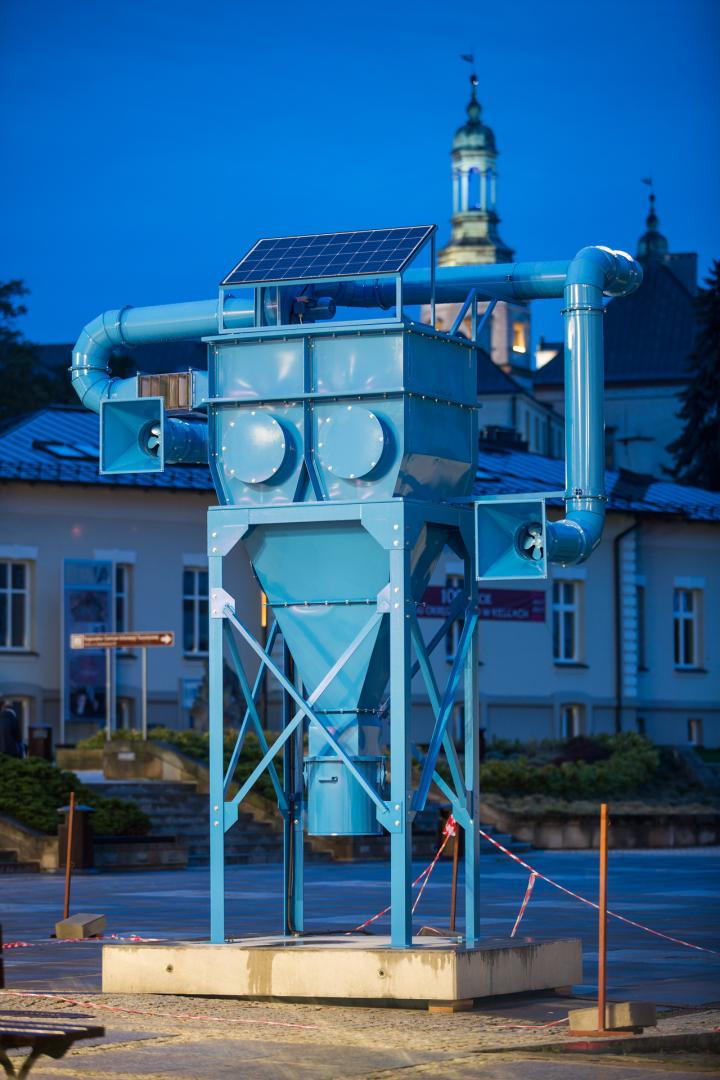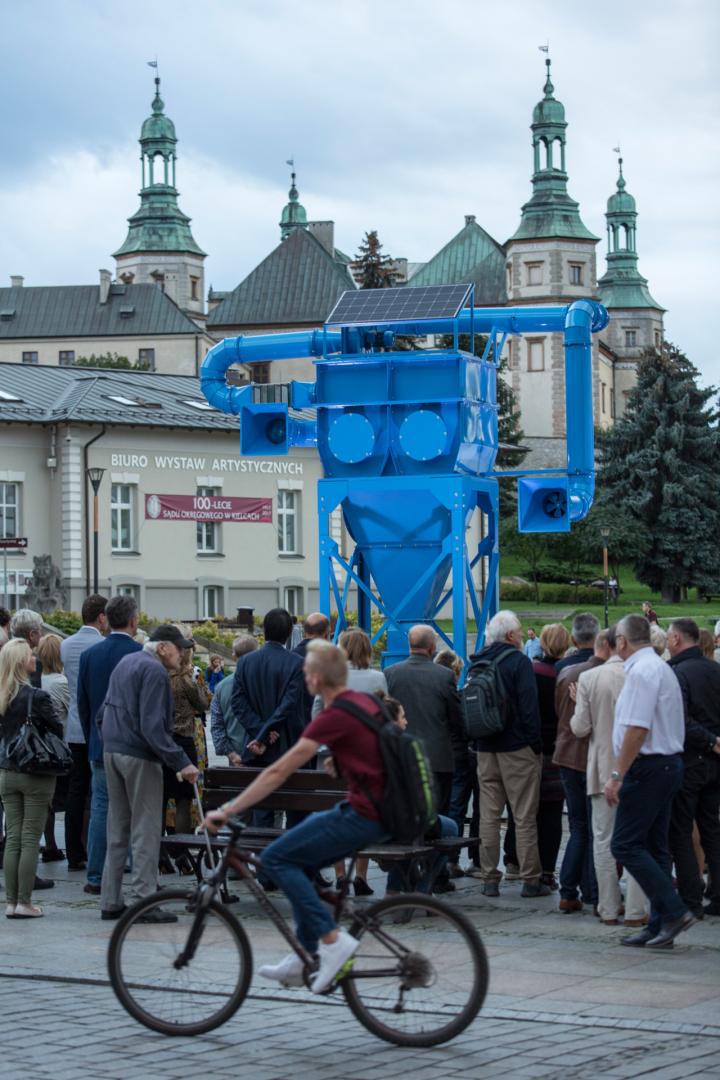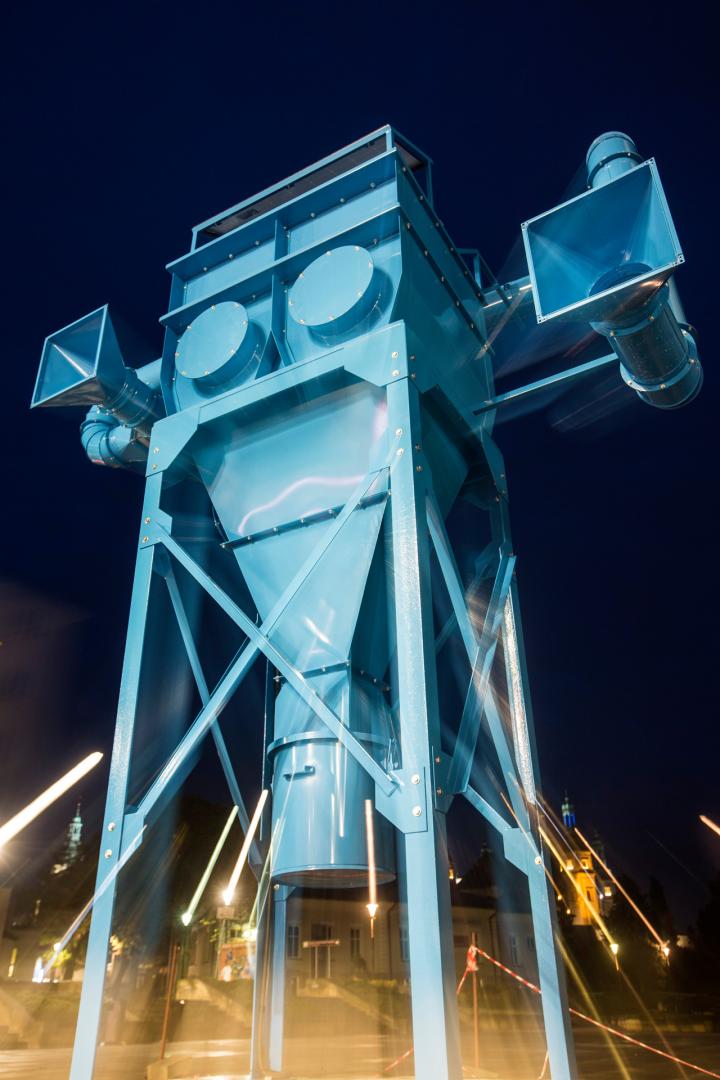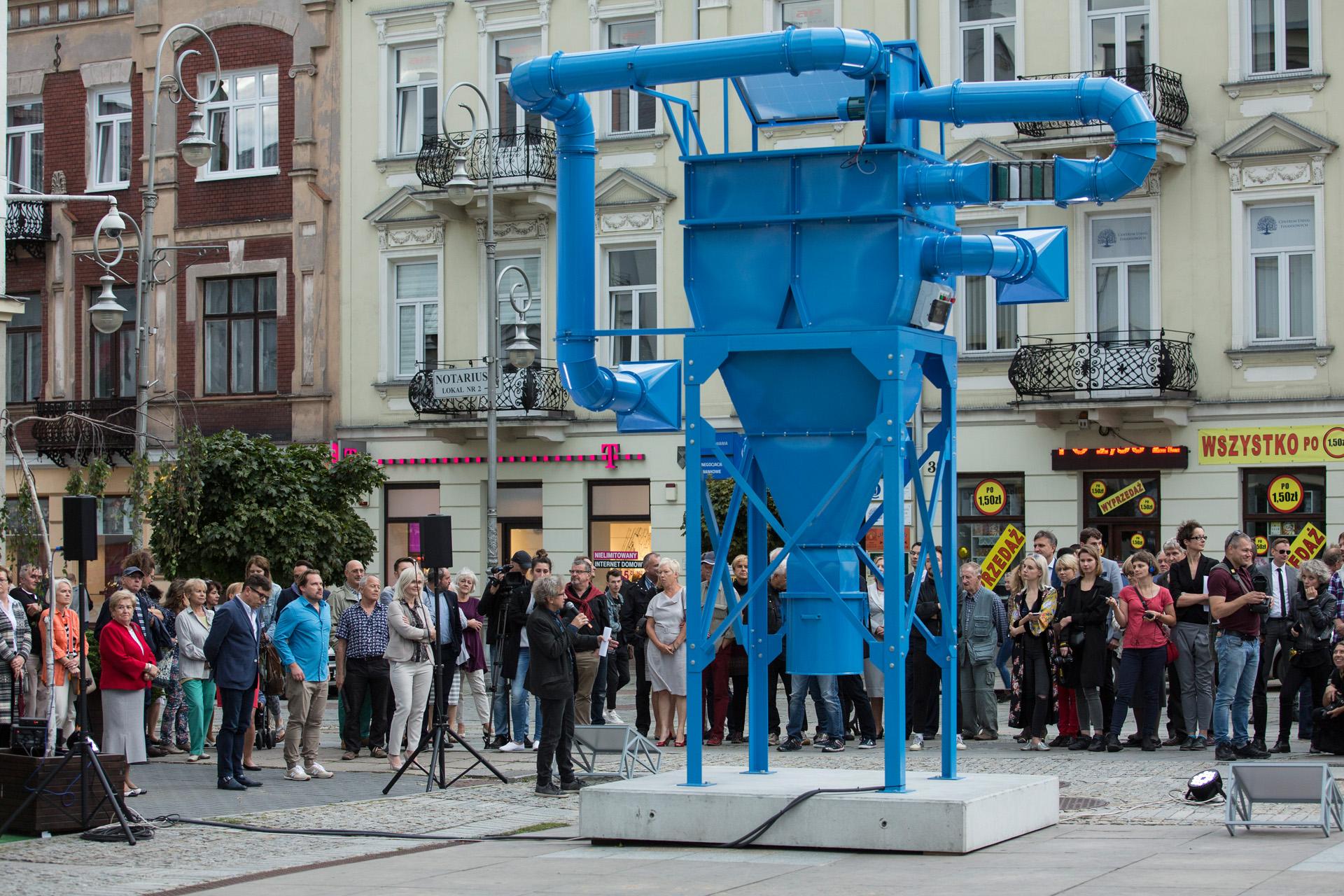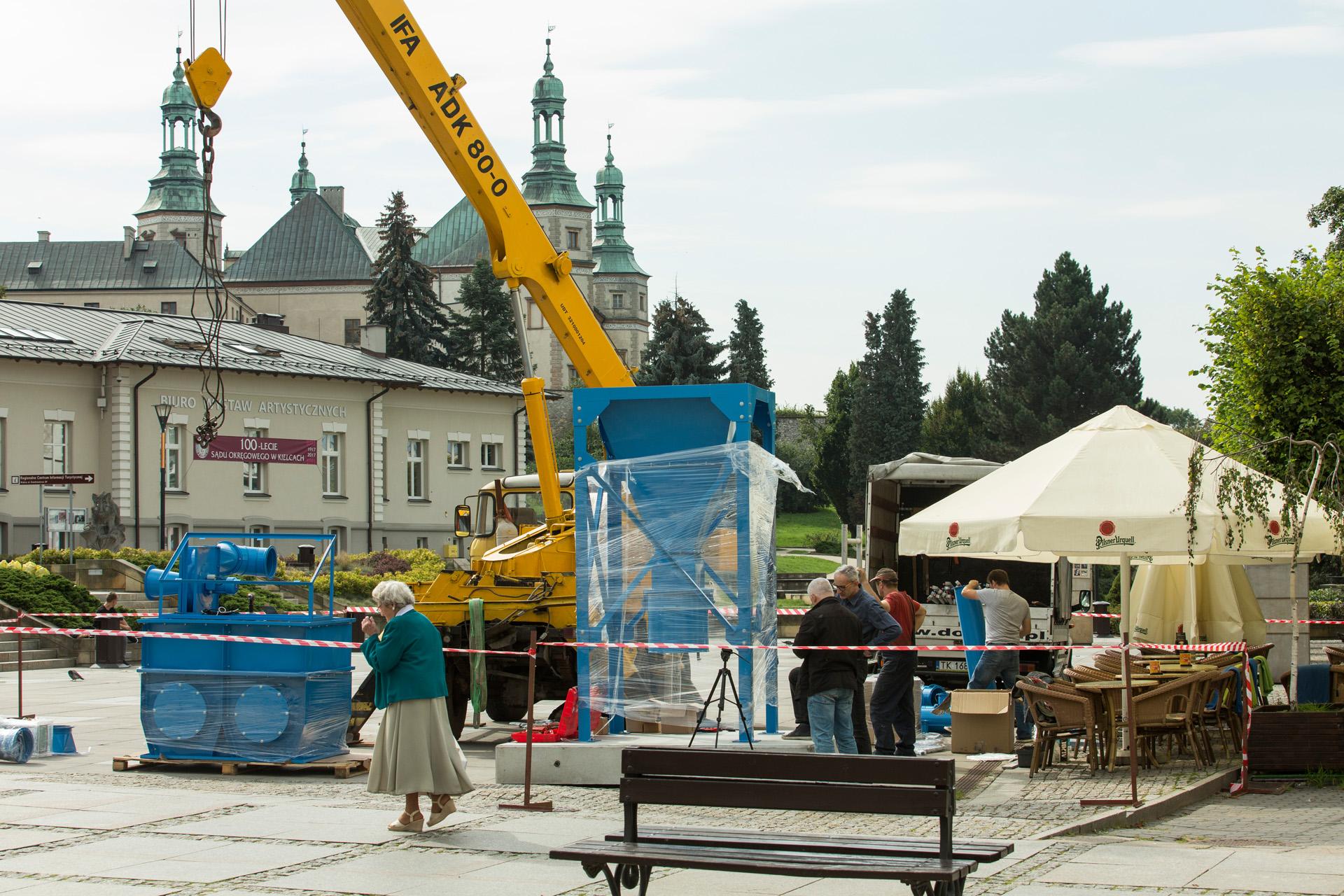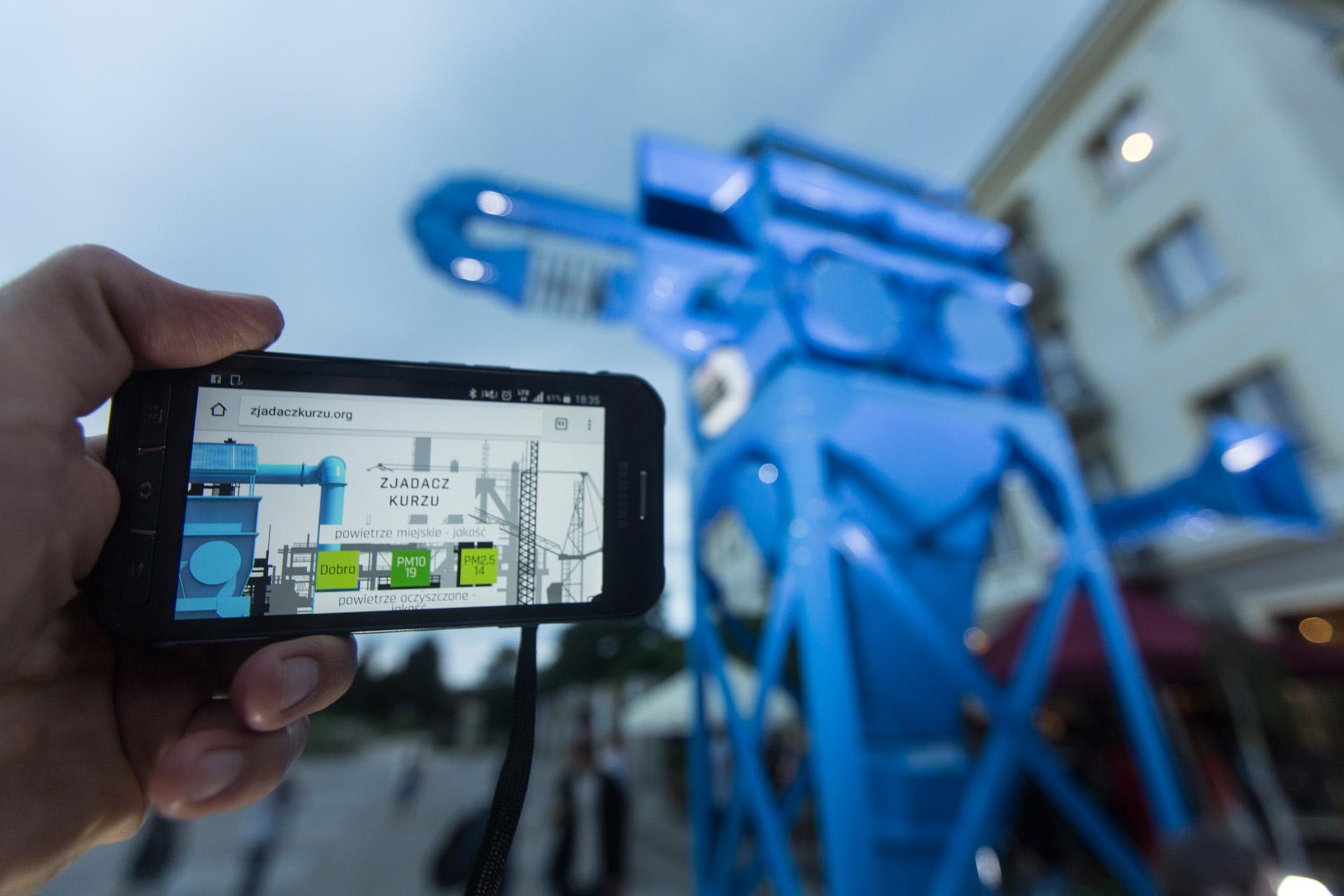Dust Eater
Basic information
Project Title
Full project title
Category
Project Description
"Dust Eater" is a sculpture by Kuba Bąkowski in the urban space. It combines remote areas of industrial engineering and post-futuristic sculpture with environmentally-oriented artistic practice. It is the result of turning an industrial device into a monumental work of art. It fulfills a futuristic postulate about the usefulness of art, retaining the function of a device and as a giant sculpture -cleaning the city air. It meets the requirements of modern times by shaping pro-ecological attitude.
Project Region
EU Programme or fund
Description of the project
Summary
"Dust Eater" is a sculptural project by Kuba Bąkowski in the urban space. It combines the seemingly remote areas of industrial engineering and post-futuristic sculpture with environmentally-oriented artistic practice. The project is the result of transforming an industrial device for air purification - a cyclone separator - into a monumental work of art. The title "Dust Eater" meets the futuristic postulate of the usefulness of art, while retaining the function of a device and, like a giant sculpture, a vacuum cleaner, cleans the city air.
At the same time the sculpture promotes knowledge about the history of the city and the region. The presence of this hybrid of art and industry in Kielce alluded to their historical affiliation to the Old Polish and then the Central Industrial District, which is the oldest mining and metallurgical district in Poland (the first flint mines were established there in the Paleolithic period).Today limestones, sandstones and quartzites are mined here. The processing of these materials is associated with the use of specific devices for segregating rock material and dust removal devices for the halls in which the raw material is processed. "Dust Eater" became a kind of hybrid of this historical and industrial theme and the present day of Kielce. The air-purifying machine sculpture refers to the historical conditions of the city and the region, promotes values related to ecology and shapes the attitude of understanding and respect for the place of residence, specifically in young viewers.
The project meets the requirements of modern times by shaping environmentally friendly attitudes. "Dust Eater" stood in the very center of the city near the main communication route and became an intriguing proposition for those who rarely came into contact with contemporary art. It is currently located in Busko-Zdroj, a spa town, where caring about clean air is extremely important.
Key objectives for sustainability
The City Purification Sculpture by Kuba Bąkowski, one of the most recognizable Polish artists of the generation born in the 1970s, takes up the futuristic postulate of the usefulness of art in a perverse way.
The artist reacted with his work to the terrifying statistics at a time when 33 Polish cities were on the black list (literally) of the 50 most polluted places in Europe. At the same time, he proved that art can be maximally functional and useful in the face of threats that our civilization brings.
The large-scale project "Dust Eater" was created by changing an industrial device into a totemic techno-sculpture. This modification was subjected to the so-called cyclone separator - machinery designed for air dedusting in factory halls. Bąkowski's animating gesture turned the separator's bowl into a monstrous head. The task of this huge vacuum cleaner sculpture is to absorb the city's dust and gradually free the city from hazardous pollutants. In the symbolic aspect, "Dust Eater" conducts a peculiar purification ritual of the region.The system of rotors supplying city air to the interior of the sculpture is powered by solar panels, it is important that the facility itself meets the environmental requirement, which it proclaims.
Due to the pro-ecological nature of the event, the information brochures were replaced with a large screen next to the sculpture, on which one could observe the parameters of the air purified by the installation available on the website of the "Dust Eater".
Key objectives for aesthetics and quality
"Dust Eater" is a positive character about stories of absorbing the negative energy of dirt and turning polluted air into clean. The procedure of animation (metaphorization consisting in assigning abstract panels of living to objects, phenomena or concepts) in the case of "The Dust Eater" changed him into the form of a mechanical giant, a fairy-tale creature, a giant toy and a mysterious artifact.
"Dust Eater" certainly focuses on a whole range of cultural references. It can become a character "recalled" directly from the works of Stanisław Lem, the author of the famous "Fairy Tales of Robots", on which the imagination of generations of Poles was built, from "Howl's Walking Castle" with anti-war meaning from the Japanese animated manga classics under the same title, the positive "Transformers" "from the film and comic book Western iconography. For others, the sculpture has become a contemporary reflection of the search for a new formula of art by the futurists of the 1920s, a contractual gesture to fulfill the postulate of the utility of art, a strange postmodern relic of the industrial expansion era, a purification of the contaminated atmosphere of our planet, or a visitor from dystopian science fiction literature and movies.
Key objectives for inclusion
The CSO research on the participation of people in culture shows that Poles are still very little interested in exhibitions and cultural activities carried out in art galleries. In response to this fact, the project "Dust Eater" implements the postulate of going beyond the gallery space, greater accessibility and openness of the world of contemporary art. Therefore, the facility for the sculpture installation was chosen in the very center of the city, next to the largest pedestrian communication route, Henryk Sienkiewicz Street.
The object is massive (appx. dimensions of the object are 6.5 m high, 2.5 m wide and 2 m deep), colorful and highly visible. The part of the concept was to complete the installation process of the „Dust Eater” directly on the site prior to the opening. The work was being assembled at the Artist’s Square (Plac Artystów) and was available for observation by city residents. It naturally preceded the opening of the exhibition and the beginning of the "Dust Eater" activities.
There was a website www.zjadaczkurzu.org, launched specifically for this project, which allowed everyone to monitor the indications and readings of city air parameters on their phones, tablets and other mobile devices. Facilitating access to the site was the wi-fi network made available for the needs of "Dust Eater".
Educational workshops involving the local community not only in creative and artistic activities, but also pro-ecological practices were also a very important element of the project. Executed with collaboration with the National Museum in Kielce and the City Art Gallery provided ground for mostly young participants to explore, create, discuss, think and find solutions.
Results in relation to category
The project is intended as a tool for shaping the ecological awareness of the communities. The key was to mobilize the viewers to actively participate in creative activities and include them in green movement around the closest neighbourhood, but also open a discussion for broader thinking in finding solutions for protecting the evironment and how the individuals can contribute to minimizing pollution and littering, use renewable energy and recycle products as much as possible. During the workshops that accompanied the event, the artist and educators were working with various groups of different ages bringing awareness to one of the most important problems of the XXI century- protecting our Planet.
"Dust Eater" and the executed workshops related to it also had shaped recipients’ interest in art and stimulated their creative imagination. The creators of the project presented art as something attractive, as a fascinating tool for understanding and describing the world. The techno-artistic "Dust Eater" showed the sense and value of understanding technology and the potential of contemporary art and its involvement in various areas of life.
The fact that the sculpture can be moved from one place to another is also very important. The “Dust Eater” had already become “a messenger” creating strong visual and intellectual impact on the places and communities where it travels to. Since its inception the “Dust Eater” had visited three sites and mobilized hundreds of people in various artistic and ecological activities that were formed around it.
How Citizens benefit
"Dust Eater" acts as a kind of "trigger" of the imagination, it stimulates free, creative associations, visions and ideas which, if skillfully animated, can be fulfilled in the creative activities of the recipients of the project. The issues related to the accessibility and attractiveness of contemporary art, building pro-ecological awareness and awareness of the historical background of the place of residence are the clou of the project. Purifying the city in the real (physical) and above all symbolic sphere, "Dust Eater" aims to stimulate the imagination and shape consciousness, and it fulfills these postulates in the form of a manifesto of a positivist world view. The project draws attention to the factors shaping reality, activates the interest in what is "here and now" by showing a wider context, both in the historical perspective and in thinking about the future (ecology and cultural and historical identity of the city and region as a background for development).
The "Dust Eater" promotes knowledge about the history of the city and the region and shapes local identity and belonging. The machine - a sculpture that cleans the air, refers to the historical conditions of the city and the region, belonging to the Central Industrial District and the traditions of mining and resource extraction. Similar devices were used to dedust the air in places where rock raw material was processed. The modified device - the sculpture shapes, especially in young viewers, an attitude of understanding and respect for the place of residence.
Innovative character
"Dust Eater" is an artistic proposition that can be fulfilled on many levels. Targeted at various age groups, it has become a fully-fledged proposal by an artist who finds inspiration in technology and natural sciences. The "Dust Eater" that devours pollution is the result of an intriguing transformation of an industrial device into a work of art, a techno-spirit totem of the industrial era. The very gesture of this transgression is a post-futuristic manifesto postulating the value of a critical look at the impact of civilization on our environment and on ourselves. The project combines art with technology, abstract thinking with utilitarian aspects and aesthetics with functionality.
“Dust Eater " is a modern sculpture, created by modifying the cyclone separator of the air dust removal device in factory halls. In nature, a cyclone is the circulation of air masses, a form of a vortex that sucks matter in due to the negative pressure inside it. The work uses this phenomenon. The air, drawn inside by the suction system, swirls in it and the contained dust is thrown away by the action of centrifugal force and is collected in a special container. Clean air flows upwards outside the sculpture. The above description alone shows how interesting and innovative Bąkowski's work is.
Its innovative characteristics lay the ground for futuristic artistical solutions to transform postindustrial landscapes into green and clean environment with fresh start for new communities creating deep ecological awareness. The “Dust Eater” is the first step in a visionary direction. Imagine a situation where the sculptures-machines are able to clean old industrial waste, maintain proper water conditions and grow plants that will attract insects, birds and other inhabitants. This would be the next step in further development of this art-industrial project.

